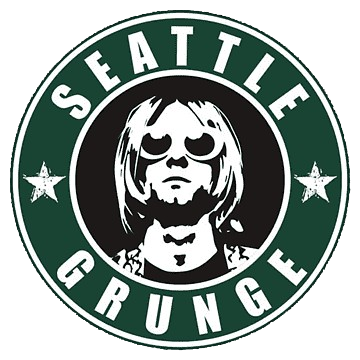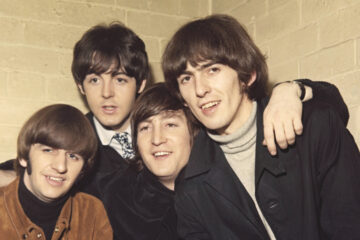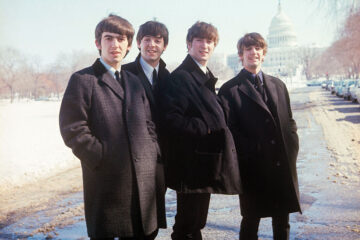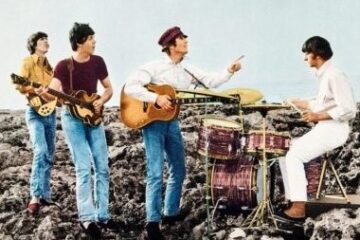One day back in the late 80s, I saw Freddie Mercury in the street. Appropriately, it was in Kensington High Street, close to his house and also to the spot where he and Roger Taylor had begun their now famous market stall. Freddie looked like he was arriving for a bash at the Roof Gardens. It was an early evening in summer. Suddenly there he was, a slight man, but upright and barrel-chested, and with a black moustache that seemed to take up at least half of his bony face.
Like many very famous people, there was a hubbub about him, and a sense of expectation. One of his pet hates was supposed to be getting recognised in public, but as the bystanders spotted him he gave everyone a small wave and a flash of those big old gnashers before gliding off. And then, remarkably, a round of applause broke out. Freddie looked back and smiled again, obviously pleased. This was post- Queen’s Live Aid triumph and pre-AIDS, and smack in the middle of Queenʼs second golden era, a time when this seemingly unimposing man could hold football stadiums full of people in his thrall.
Itʼs easy now to remember Freddie Mercury just as he was in his later years: fey and restrained, rarely seen, reclining in luxury with his cats and his jewellery. Even before the burdens of terminal illness he gave the impression of a man whoʼd had his fill. In the rare interviews he gave there was no Radiohead-style introspection, but instead an affecting sadness.
But in his pomp – open-chested leotard, ballet slippers, mad mop of black hair, teeth courtesy of Red Rum – Freddie Mercury and Queen were a gloriously unashamed metal band. They were a bravura show, mad and excessive enough for NMEʼs famously humourless journalist Nick Kent to call them “a bucket of urine”. But Freddie was special, he knew it, and he didnʼt give two hoots who knew that he knew it, either.
“Freddie Mercuryʼs a pretty regular guy,” NME reported back in 1974, with a complete lack of prescience. “He uses regular Biba black nail varnish, regular black eye liner, and straightens his hair with regular electric tongs. You get the idea that heʼs bored with being told that Queen are going to be big – he reckons heʼs a star now, and wears that star apparent attitude like a well-fitted pair of trousers. Freddieʼs not bent, just camp. Ask him if heʼs queer and heʼll turn round and say: Iʼm as gay as a daffodil, dear.ʼ He has a habit of saying dearʼ at the end of every sentence. Drummer Roger Taylor expounds: Freddieʼs just his natural self: just a poof, really.ʼ”
Freddie Mercury was Britain’s first Indian rock star. This fact and the nature of his sexuality were the two areas of his short life about which he would be intentionally obscure. Although he was born on the East African island of Zanzibar on September 5, 1946, his parents were both Indian; they were Parsees from Gujarat. Mercury would often make note of his Persian roots, but the Parsees had been driven from Persia a thousand years before.
They landed on the Gujarat coast and populated its greatest city, Bombay. Every Patel in the world can trace their roots to Gujarat. The Encyclopedia Britannica says of the men: “They have light olive complexions, a fine aquiline nose, bright black eyes, a well-turned chin, heavy arched eyebrows, and thick lips, and usually wear a light curling moustache.” Sounds familiar, somehow. The Parsee faith worship Zarathrustra, later adopted by the philosopher Fredrich Nietzsche.
Bomi Bulsara, Freddieʼs father, had actually taken his surname from Bulsar, the small town north of Bombay and south of Ahmedabad that he grew up in. Thereʼs a strong trend towards emigration from the province, too. There are said to be more Indian immigrants from Gujarat than anywhere else on the subcontinent. Bomi and his wife Jer travelled to Zanzibar, where Bomi worked as a cashier in the High Court. He and Jer, from whom Freddie inherited both his fine bones and protruding teeth, christened him Farrokh. Kashmira, Freddieʼs sister, came along six years later.
Freddie would not set foot in England until he was 17. His background was almost wholly Indian. His early childhood on Zanzibar (the island is known as the Isle of Spices) sounds idyllic. For 10 years he was educated near Bombay at St Peterʼs School. Family pictures show Freddie as an emergent showman, grinning his toothy grin from winnersʼ podiums on sports days (his sister has kept some of his trophies, including an unlikely one for boxing), one of which has an older Freddie looking like a youthful Gatsby in sunglasses, linen slacks and two-tone shoes.
Thereʼs also a rare shot of his first band, the Hectics, who performed rockʼnʼroll standards by Buddy Holly, Bill Haley and the like, with Freddie on piano and sometimes vocals too. School wasnʼt entirely the colonial idyll, though. In 1984, he remembered: “All the things they say about them [boarding schools] are more or less true. All the bullying and everything else. Iʼve had the odd schoolmaster chasing me. It didnʼt shock me, because somehow boarding schools… youʼre not confronted by it, you are just slowly aware of it. Itʼs going through life.”
So was Freddie the pretty boy who everyone wanted to lay? “Funnily enough, yes. Anybody goes through that. I was considered the arch poof. Letʼs put it this way: there were times when I was young and green. Itʼs a thing schoolboys go through. Iʼve had my share of schoolboy pranks. Iʼm not going to elaborate further.”
In Zanzibar in 1964, there was an uprising against British rule, and the Bulsaras were faced with a choice: they, in common with the Sultanateʼs other Indian residents, were given six months to settle elsewhere. Freddie, Jer Bulsara remembers, was keen on England. The family travelled from the Isle of Spices in the Indian Ocean, and fetched up in sunny Feltham, West Middlesex, right under the Heathrow flight path. They bought a small terraced house in which Bomi and Jer would live for the rest of Freddieʼs life. Freddie was 17 when he arrived in England, yet he seemed to have little difficulty in settling in. If there was any kind of culture shock, it was a retrospective one.
“Well, I kind of grew up in India,” he said. “I saw a lot of poverty over there, but itʼs sort of… You can only sort of reflect poverty when youʼre here, if you know what I mean. If youʼre there, itʼs a norm, it really is. You expect beggars in the street and all that. To people living there, or if youʼre brought up there, you actually believe thatʼs the way of life. So I think when I was a young baby I was just, you know. I was in an English boarding school, and itʼs like, I had boundaries where I couldnʼt go, and I looked upon that and I just thought that was the way India is.”
Freddieʼs hero was Jimi Hendrix. It was hard to see much of him in Zanzibar or Bombay, but in London he could – and did – watch Hendrix play on nine consecutive nights. He could also shop at Biba, buy hippy gear at Kensington Market, and be on hand for the counter-cultural revolution.
He went to Ealing College of Art in 1966 – a hip joint whose alumni included Pete Townshend of The Who, and Ron Wood, guitarist with the Faces and later the Rolling Stones – and graduated with a Diploma in Graphic Art and Design in 1969. He lived in a rented flat in Kensington, and started a market stall with his new friend, Roger Taylor.
“We were selling artwork from some of the students at Ealing,”Taylor recalled. “Then we sold Fredʼs thesis, which was all based on Hendrix. Things like that are probably worth a lot of money now.”
Freddie had met Roger through a mutual friend, Tim Staffell. Staffell and Taylor had a band, Smile, with Brian May. Freddie liked Smile, and he was impressed by Mayʼs major claim to fame: his previous band, 1984, had supported Jimi Hendrix at a gig at Londonʼs Imperial College.
“Iʼd put a lot of work into playing guitar,” May remembered, “and was thinking I was pretty damn good. But Hendrix came along and destroyed everyone. I was deeply jealous, that was the first emotion I felt. Astronomy was going to be my career. Thatʼs what my parents were hoping I would do, really. They wanted me to do a proper job, as we call it in England, and not loon around playing guitars and making a noise.
“So I did my studies, finished school, got my O Levels, got my A levels. I went to Imperial College, did three years and got a BSc Honours in physics, which had a fair bit of astronomy in it, and then I did four years post-graduate for the PhD in astronomy, but I never finished writing the thing up. I published a couple of papers with my supervisor, but thatʼs where I left it. And I donʼt regret leaving it. It was the right time.”
Freddie made an impression on May, too, even though he wasnʼt quite sure why: “Even back then Freddie knew he would be a star. He had no money in his pocket, no success to speak of yet, or even any hope of success, but it didnʼt stop him. He acts the way he does because thatʼs the way he really is.”
Smile somehow evolved into Queen, with May and Taylor joining Freddie, who had by now adopted the rising star in his birth sign, Mercury, as his stage name. John Deacon got the gig after one of the bandʼs girlfriends became friendly with his. By 1970 Queen were gigging, and in 1971 they supported Yes at Imperial College (admission: 50p).
They were no overnight success; Queen I would not emerge for another three years. Freddie: “The moment we made a demo we were aware of the sharks. We had such amazing offers from people saying: Weʼll make you the next T.Rexʼ. But we were careful not to jump straight in. We went to about every company before we finally settled. We didnʼt want to be treated like an ordinary band.
The character of Queen was beginning to emerge. Mercury gave free reign to his natural flamboyance, sucking in a myriad of influences: Hendrix, of course, but also Bowie and glam rock, the thrilling blues power of Led Zeppelin, and the arch art-school madness of proggies like Yes and ELP. As the band defined themselves musically, its character was set, too.
“Everyone,” according to Freddie at the time, “is very highly strung.” The singer even more so. “Iʼm very emotional,” he said. “Whereas before, I was given time to make my decisions, now nearly all of us are so highly strung we just snap. We always argue, but I think itʼs a healthy sign, because we get to the root of the matter and squeeze the best out. But lately so much is happening, itʼs escalating so fast that everybody wants to know almost instantly, and I certainly get very temperamental.”
Queen I, released on July 13, 1973, sold reasonably in America, and the single, Keep Yourself Alive, was championed by the Old Grey Whistle Test. For some reason or another, Queen were hugely popular in Taunton.
The truly iconic Queen did not begin until Queen II and even then the band found themselves visually before they did musically. Theyʼd begun working with the photographer Mick Rock, noted for his pictures of David Bowie and, earlier, Pink Floydʼs Syd Barrett.




